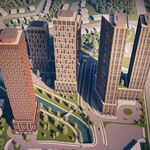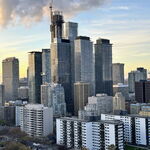sixrings
Senior Member
I’ve never seen a thread with such a high ratio of new members to senior members. Enjoy dreaming and then watching those dreams be crushed.
The length of LRVs mean absolutely nothing. The requirements of stop spacing has less to do with the vehicles, and more to do with the environment they're being run in. Every single station you include increases travel time, and when you are in a suburban setting, time is everything. Not only are you serving a highly low density area, but you're also in an area where car travel is incredibly competitive, and if you cannot provide a service that is somewhat competitive with the car outside of rush hour, you are wasting money. Stop spacing has nothing to do with mode, and everything to do with the density and environment the line is being run in. Now looking at the map and the actual distances, this line is probably fine. I am a bit iffy about having both a station at Winchester and Winfields farm with them being 400m, but I digress.It seems close in the drawing but they are pretty spaced out in reality. It’s also an LRT so they won’t be as long as subway cars.
Thanks for the insight, I’m obviously not a planner so I just drew down an idea with no consideration of the points you made above. However, I will have to disagree on your statement about the area being low density. Yes, that is the situation currently but there are many developments that will pop up along that corridor over the next 10 years and beyond. For example you have the University/College campus master plan, WInfields Farm, U.C towers, student housing, plaza redevelopments, old bungalows being demolished for intensification, downtown developments and many more. The area will have more density so yes subways and underground LRTs infrastructure is costly but you have to consider the long term vision as well. In addition, i don’t think it would be feasible to build an elevated station on Simcoe street but the idea would be cool.The length of LRVs mean absolutely nothing. The requirements of stop spacing has less to do with the vehicles, and more to do with the environment they're being run in. Every single station you include increases travel time, and when you are in a suburban setting, time is everything. Not only are you serving a highly low density area, but you're also in an area where car travel is incredibly competitive, and if you cannot provide a service that is somewhat competitive with the car outside of rush hour, you are wasting money. Stop spacing has nothing to do with mode, and everything to do with the density and environment the line is being run in. Now looking at the map and the actual distances, this line is probably fine. I am a bit iffy about having both a station at Winchester and Winfields farm with them being 400m, but I digress.
What I do want to bring up though (and this is something I didn't notice the first time) is just how much of this line is underground. The problem here as we have learned with Eglinton, all that you're doing when building an LRT that's mostly underground is you're building a line that has the drawbacks of LRTs and Subways, with none of the benefits - you have the huge capital cost and delay/long construction time of a subway, whilst you're also stuck with the large maintenance cost and reliability issues that come with LRTs. If you want to have most of the line be underground, go elevated for the last section and save yourself a large amount of money by using smaller trains, building smaller (and thus significantly cheaper) stations, and using automation and high frequencies to make up for the lost capacity, as well as save up on the operational cost. If you really want to use LRTs, try to bury as little of it as possible, make simcoe street 1 lane in downtown if possible. Trying to do both just leads to madness.
I really do not understand going underground between Conlin and Robert when the right-of-way is 20m+... Hell there's even space for 2 lanes of traffic and 2 LRT tracks all the way to Adelaide/Brock street. Mixing modes is generally problematic as @ARG1 says as you get the drawbacks of an LRT without the full benefits of a subway.An idea we created for the current Simcoe rapid transit study being conducted by Durham Region. We believe an LRT would be the best fit. Below is a map of all the suggested stops. View attachment 441543
Thanks for your comments, we will create a newer plan by the end of the week. Again, I’m not a planner but I’m happy this created conversation for suggestions and learning opportunities. The main reason why I suggested an underground tunnel between Conlin’s and Adelaide is because in order to widen the road it would require property space from home owners along that stretch (At least from Roberts to Adelaide). I do agree that from Conlins to Roberts, for the most part the road can be widen and keep two lane traffic in both directions.I really do not understand going underground between Conlin and Robert when the right-of-way is 20m+... Hell there's even space for 2 lanes of traffic and 2 LRT tracks all the way to Adelaide/Brock street. Mixing modes is generally problematic as @ARG1 says as you get the drawbacks of an LRT without the full benefits of a subway.
There is an argument for a short LRT tunnel in downtown Oshawa but it would likely only involve 2-4 below grade stations.
I drew the intersection at Simcoe and Rossland. This example shows the scenario with middle bus lanes and the existing roadway. In order to have 2 traffic lanes in both directions (or 2 traffic lanes in one direction /1 in the other) and also sidewalks for pedestrians. The road would have to be widen significantly onto existing properties.I really do not understand going underground between Conlin and Robert when the right-of-way is 20m+... Hell there's even space for 2 lanes of traffic and 2 LRT tracks all the way to Adelaide/Brock street. Mixing modes is generally problematic as @ARG1 says as you get the drawbacks of an LRT without the full benefits of a subway.
There is an argument for a short LRT tunnel in downtown Oshawa but it would likely only involve 2-4 below grade stations.
I think everyone forgets that the whole stretch of Simcoe street is mainly residential units. Bungalows and homes that have been there for ages. This isn’t Hwy2 where it’s mostly plazas/businesses with a corridor that could have more than 4 lanes in each direction. That’s why it’s feasible to make a BRT along that stretch. With Simcoe from Conlin’s to Hwy407, it’s easy to have an at grade BRT or LRT because developments were built a distance from the road to allow for widening. However past Roberts and going south to Downtown Oshawa, the road isn’t as wide. So to build an LRT or BRT above ground, wouldn’t be feasible.I did a google streetsview and I realize that these houses front lawns are very worthy of being kept. Digging underground is the way to go. If central eglinton deserved to be underground surely this section does as well. If bramptons downtown deserves to be downtown than surely Oshawas does as well. These are some historic houses we are talking about and they are going to be the building blocks of a new urban and transit friendly development.
I wouldn’t say deserving of subways but the region is conducting this study because it is corridor that would be beneficial of rapid transit in the near future. This line would connect Durham college/ONTechU to Hwy407, the new Ritson Go station, Lakeridge Health, Downtown Oshawa and many more urban areas. There is a lot of mixed-use and residential applications along that stretch as of now and more are coming. However, I think it’s unfair that we always compare ourselves to Toronto in terms of what we can have or not. Yes Toronto’s population is bigger but everyone has to start from somewhere.And now we're back in the territory of "deserving" subways, not in high-rise areas, but through low-density, upper-middle class houses with little ridership or potential growth. Yet still nothing on Queen's Quay East. OK.
If you couldn’t read the massive sarcasm in my post then despite all your nice maps you have posted perhaps you are are too oblivious to lead the future of Durhams transit plans. Nice maps though.I agree, I think everyone forgets that the whole stretch of Simcoe street is mainly residential units. Bungalows and homes that have been there for ages. This isn’t Hwy2 where it’s mostly plazas/businesses with a corridor that could have more than 4 lanes in each direction. That’s why it’s feasible to make a BRT along that stretch. With Simcoe from Conlin’s to Hwy407, it’s easy to have an at grade BRT or LRT because developments were built a distance from the road to allow for widening. However past Roberts and going south to Downtown Oshawa, the road isn’t as wide. So to build an LRT or BRT above ground, wouldn’t be feasible.
Lol it’s hard to read sarcasm through your post when you didn’t state anything out of the ordinary or that isn’t feasible. To illiterate again, I’m not a planner and do not have any say towards the future of this corridor. I’m simply sharing ideas to show potential routes and start conversation. I appreciate your feedback and everyone else’s. I do plan to create a new map and will share it. Let me know if you have any suggestions and I can incorporate them as well.If you couldn’t read the massive sarcasm in my post then despite all your nice maps you have posted perhaps you are are too oblivious to lead the future of Durhams transit plans. Nice maps though.
Where is this from?





